Chang Wen Chen
Compile Scene Graphs with Reinforcement Learning
Apr 18, 2025Abstract:Next token prediction is the fundamental principle for training large language models (LLMs), and reinforcement learning (RL) further enhances their reasoning performance. As an effective way to model language, image, video, and other modalities, the use of LLMs for end-to-end extraction of structured visual representations, such as scene graphs, remains underexplored. It requires the model to accurately produce a set of objects and relationship triplets, rather than generating text token by token. To achieve this, we introduce R1-SGG, a multimodal LLM (M-LLM) initially trained via supervised fine-tuning (SFT) on the scene graph dataset and subsequently refined using reinforcement learning to enhance its ability to generate scene graphs in an end-to-end manner. The SFT follows a conventional prompt-response paradigm, while RL requires the design of effective reward signals. Given the structured nature of scene graphs, we design a graph-centric reward function that integrates node-level rewards, edge-level rewards, and a format consistency reward. Our experiments demonstrate that rule-based RL substantially enhances model performance in the SGG task, achieving a zero failure rate--unlike supervised fine-tuning (SFT), which struggles to generalize effectively. Our code is available at https://github.com/gpt4vision/R1-SGG.
VideoMind: A Chain-of-LoRA Agent for Long Video Reasoning
Mar 17, 2025Abstract:Videos, with their unique temporal dimension, demand precise grounded understanding, where answers are directly linked to visual, interpretable evidence. Despite significant breakthroughs in reasoning capabilities within Large Language Models, multi-modal reasoning - especially for videos - remains unexplored. In this work, we introduce VideoMind, a novel video-language agent designed for temporal-grounded video understanding. VideoMind incorporates two key innovations: (i) We identify essential capabilities for video temporal reasoning and develop a role-based agentic workflow, including a planner for coordinating different roles, a grounder for temporal localization, a verifier to assess temporal interval accuracy, and an answerer for question-answering. (ii) To efficiently integrate these diverse roles, we propose a novel Chain-of-LoRA strategy, enabling seamless role-switching via lightweight LoRA adaptors while avoiding the overhead of multiple models, thus balancing efficiency and flexibility. Extensive experiments on 14 public benchmarks demonstrate that our agent achieves state-of-the-art performance on diverse video understanding tasks, including 3 on grounded video question-answering, 6 on video temporal grounding, and 5 on general video question-answering, underscoring its effectiveness in advancing video agent and long-form temporal reasoning.
FedPCA: Noise-Robust Fair Federated Learning via Performance-Capacity Analysis
Mar 13, 2025Abstract:Training a model that effectively handles both common and rare data-i.e., achieving performance fairness-is crucial in federated learning (FL). While existing fair FL methods have shown effectiveness, they remain vulnerable to mislabeled data. Ensuring robustness in fair FL is therefore essential. However, fairness and robustness inherently compete, which causes robust strategies to hinder fairness. In this paper, we attribute this competition to the homogeneity in loss patterns exhibited by rare and mislabeled data clients, preventing existing loss-based fair and robust FL methods from effectively distinguishing and handling these two distinct client types. To address this, we propose performance-capacity analysis, which jointly considers model performance on each client and its capacity to handle the dataset, measured by loss and a newly introduced feature dispersion score. This allows mislabeled clients to be identified by their significantly deviated performance relative to capacity while preserving rare data clients. Building on this, we introduce FedPCA, an FL method that robustly achieves fairness. FedPCA first identifies mislabeled clients via a Gaussian Mixture Model on loss-dispersion pairs, then applies fairness and robustness strategies in global aggregation and local training by adjusting client weights and selectively using reliable data. Extensive experiments on three datasets demonstrate FedPCA's effectiveness in tackling this complex challenge. Code will be publicly available upon acceptance.
What Makes a Scene ? Scene Graph-based Evaluation and Feedback for Controllable Generation
Nov 23, 2024



Abstract:While text-to-image generation has been extensively studied, generating images from scene graphs remains relatively underexplored, primarily due to challenges in accurately modeling spatial relationships and object interactions. To fill this gap, we introduce Scene-Bench, a comprehensive benchmark designed to evaluate and enhance the factual consistency in generating natural scenes. Scene-Bench comprises MegaSG, a large-scale dataset of one million images annotated with scene graphs, facilitating the training and fair comparison of models across diverse and complex scenes. Additionally, we propose SGScore, a novel evaluation metric that leverages chain-of-thought reasoning capabilities of multimodal large language models (LLMs) to assess both object presence and relationship accuracy, offering a more effective measure of factual consistency than traditional metrics like FID and CLIPScore. Building upon this evaluation framework, we develop a scene graph feedback pipeline that iteratively refines generated images by identifying and correcting discrepancies between the scene graph and the image. Extensive experiments demonstrate that Scene-Bench provides a more comprehensive and effective evaluation framework compared to existing benchmarks, particularly for complex scene generation. Furthermore, our feedback strategy significantly enhances the factual consistency of image generation models, advancing the field of controllable image generation.
E.T. Bench: Towards Open-Ended Event-Level Video-Language Understanding
Sep 26, 2024



Abstract:Recent advances in Video Large Language Models (Video-LLMs) have demonstrated their great potential in general-purpose video understanding. To verify the significance of these models, a number of benchmarks have been proposed to diagnose their capabilities in different scenarios. However, existing benchmarks merely evaluate models through video-level question-answering, lacking fine-grained event-level assessment and task diversity. To fill this gap, we introduce E.T. Bench (Event-Level & Time-Sensitive Video Understanding Benchmark), a large-scale and high-quality benchmark for open-ended event-level video understanding. Categorized within a 3-level task taxonomy, E.T. Bench encompasses 7.3K samples under 12 tasks with 7K videos (251.4h total length) under 8 domains, providing comprehensive evaluations. We extensively evaluated 8 Image-LLMs and 12 Video-LLMs on our benchmark, and the results reveal that state-of-the-art models for coarse-level (video-level) understanding struggle to solve our fine-grained tasks, e.g., grounding event-of-interests within videos, largely due to the short video context length, improper time representations, and lack of multi-event training data. Focusing on these issues, we further propose a strong baseline model, E.T. Chat, together with an instruction-tuning dataset E.T. Instruct 164K tailored for fine-grained event-level understanding. Our simple but effective solution demonstrates superior performance in multiple scenarios.
Exploring Rich Subjective Quality Information for Image Quality Assessment in the Wild
Sep 09, 2024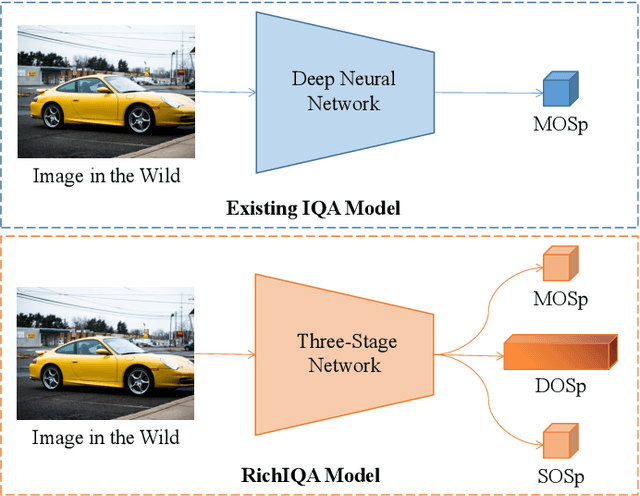


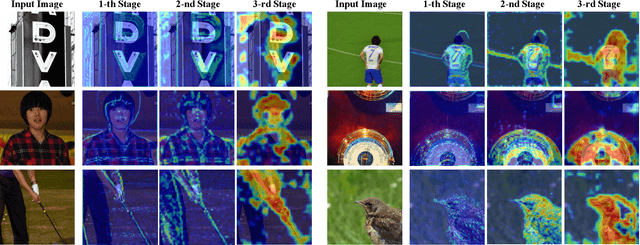
Abstract:Traditional in the wild image quality assessment (IQA) models are generally trained with the quality labels of mean opinion score (MOS), while missing the rich subjective quality information contained in the quality ratings, for example, the standard deviation of opinion scores (SOS) or even distribution of opinion scores (DOS). In this paper, we propose a novel IQA method named RichIQA to explore the rich subjective rating information beyond MOS to predict image quality in the wild. RichIQA is characterized by two key novel designs: (1) a three-stage image quality prediction network which exploits the powerful feature representation capability of the Convolutional vision Transformer (CvT) and mimics the short-term and long-term memory mechanisms of human brain; (2) a multi-label training strategy in which rich subjective quality information like MOS, SOS and DOS are concurrently used to train the quality prediction network. Powered by these two novel designs, RichIQA is able to predict the image quality in terms of a distribution, from which the mean image quality can be subsequently obtained. Extensive experimental results verify that the three-stage network is tailored to predict rich quality information, while the multi-label training strategy can fully exploit the potentials within subjective quality rating and enhance the prediction performance and generalizability of the network. RichIQA outperforms state-of-the-art competitors on multiple large-scale in the wild IQA databases with rich subjective rating labels. The code of RichIQA will be made publicly available on GitHub.
Prior Knowledge Integration via LLM Encoding and Pseudo Event Regulation for Video Moment Retrieval
Jul 23, 2024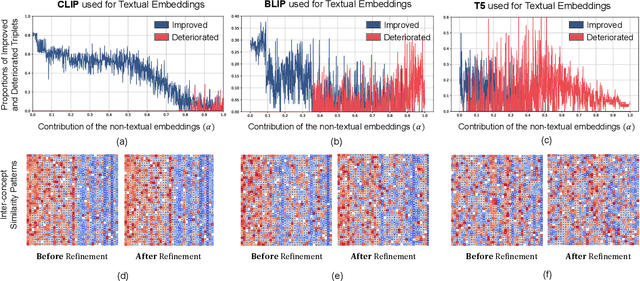
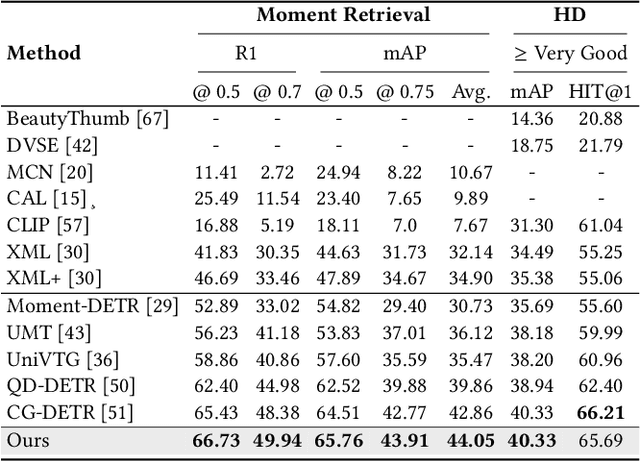
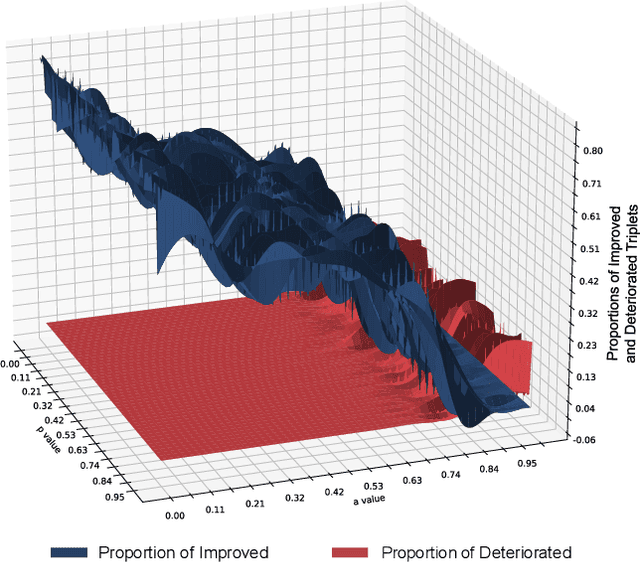
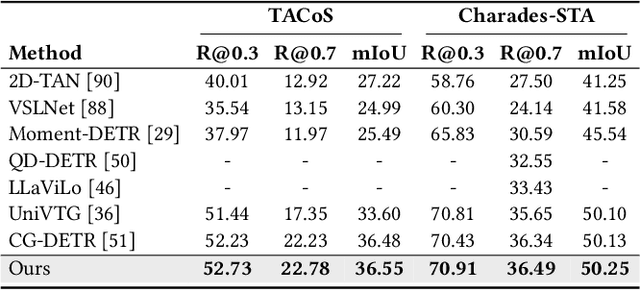
Abstract:In this paper, we investigate the feasibility of leveraging large language models (LLMs) for integrating general knowledge and incorporating pseudo-events as priors for temporal content distribution in video moment retrieval (VMR) models. The motivation behind this study arises from the limitations of using LLMs as decoders for generating discrete textual descriptions, which hinders their direct application to continuous outputs like salience scores and inter-frame embeddings that capture inter-frame relations. To overcome these limitations, we propose utilizing LLM encoders instead of decoders. Through a feasibility study, we demonstrate that LLM encoders effectively refine inter-concept relations in multimodal embeddings, even without being trained on textual embeddings. We also show that the refinement capability of LLM encoders can be transferred to other embeddings, such as BLIP and T5, as long as these embeddings exhibit similar inter-concept similarity patterns to CLIP embeddings. We present a general framework for integrating LLM encoders into existing VMR architectures, specifically within the fusion module. Through experimental validation, we demonstrate the effectiveness of our proposed methods by achieving state-of-the-art performance in VMR. The source code can be accessed at https://github.com/fletcherjiang/LLMEPET.
PosterLLaVa: Constructing a Unified Multi-modal Layout Generator with LLM
Jun 05, 2024Abstract:Layout generation is the keystone in achieving automated graphic design, requiring arranging the position and size of various multi-modal design elements in a visually pleasing and constraint-following manner. Previous approaches are either inefficient for large-scale applications or lack flexibility for varying design requirements. Our research introduces a unified framework for automated graphic layout generation, leveraging the multi-modal large language model (MLLM) to accommodate diverse design tasks. In contrast, our data-driven method employs structured text (JSON format) and visual instruction tuning to generate layouts under specific visual and textual constraints, including user-defined natural language specifications. We conducted extensive experiments and achieved state-of-the-art (SOTA) performance on public multi-modal layout generation benchmarks, demonstrating the effectiveness of our method. Moreover, recognizing existing datasets' limitations in capturing the complexity of real-world graphic designs, we propose two new datasets for much more challenging tasks (user-constrained generation and complicated poster), further validating our model's utility in real-life settings. Marking by its superior accessibility and adaptability, this approach further automates large-scale graphic design tasks. The code and datasets will be publicly available on https://github.com/posterllava/PosterLLaVA.
$R^2$-Tuning: Efficient Image-to-Video Transfer Learning for Video Temporal Grounding
Mar 31, 2024Abstract:Video temporal grounding (VTG) is a fine-grained video understanding problem that aims to ground relevant clips in untrimmed videos given natural language queries. Most existing VTG models are built upon frame-wise final-layer CLIP features, aided by additional temporal backbones (e.g., SlowFast) with sophisticated temporal reasoning mechanisms. In this work, we claim that CLIP itself already shows great potential for fine-grained spatial-temporal modeling, as each layer offers distinct yet useful information under different granularity levels. Motivated by this, we propose Reversed Recurrent Tuning ($R^2$-Tuning), a parameter- and memory-efficient transfer learning framework for video temporal grounding. Our method learns a lightweight $R^2$ Block containing only 1.5% of the total parameters to perform progressive spatial-temporal modeling. Starting from the last layer of CLIP, $R^2$ Block recurrently aggregates spatial features from earlier layers, then refines temporal correlation conditioning on the given query, resulting in a coarse-to-fine scheme. $R^2$-Tuning achieves state-of-the-art performance across three VTG tasks (i.e., moment retrieval, highlight detection, and video summarization) on six public benchmarks (i.e., QVHighlights, Charades-STA, Ego4D-NLQ, TACoS, YouTube Highlights, and TVSum) even without the additional backbone, demonstrating the significance and effectiveness of the proposed scheme. Our code is available at https://github.com/yeliudev/R2-Tuning.
SubjectDrive: Scaling Generative Data in Autonomous Driving via Subject Control
Mar 28, 2024



Abstract:Autonomous driving progress relies on large-scale annotated datasets. In this work, we explore the potential of generative models to produce vast quantities of freely-labeled data for autonomous driving applications and present SubjectDrive, the first model proven to scale generative data production in a way that could continuously improve autonomous driving applications. We investigate the impact of scaling up the quantity of generative data on the performance of downstream perception models and find that enhancing data diversity plays a crucial role in effectively scaling generative data production. Therefore, we have developed a novel model equipped with a subject control mechanism, which allows the generative model to leverage diverse external data sources for producing varied and useful data. Extensive evaluations confirm SubjectDrive's efficacy in generating scalable autonomous driving training data, marking a significant step toward revolutionizing data production methods in this field.
 Add to Chrome
Add to Chrome Add to Firefox
Add to Firefox Add to Edge
Add to Edge